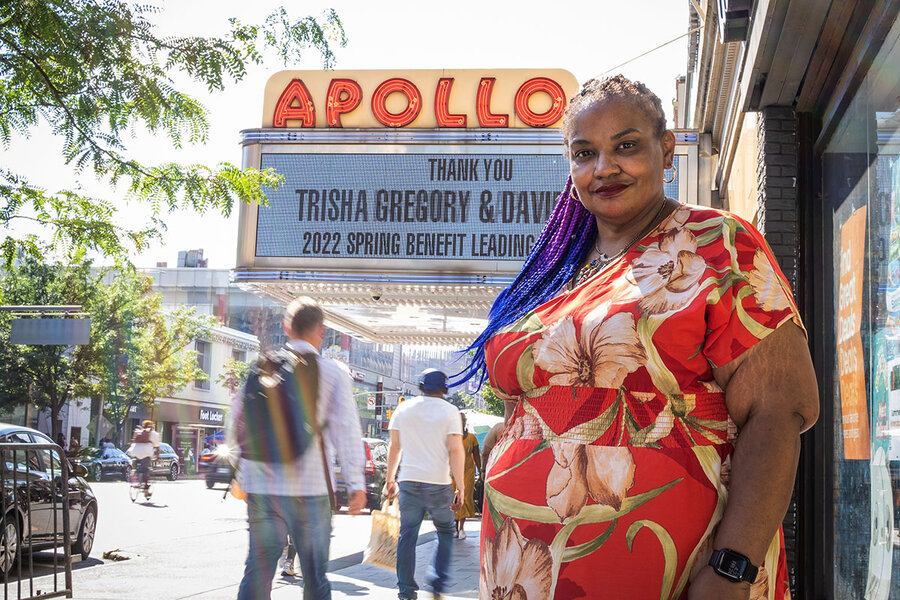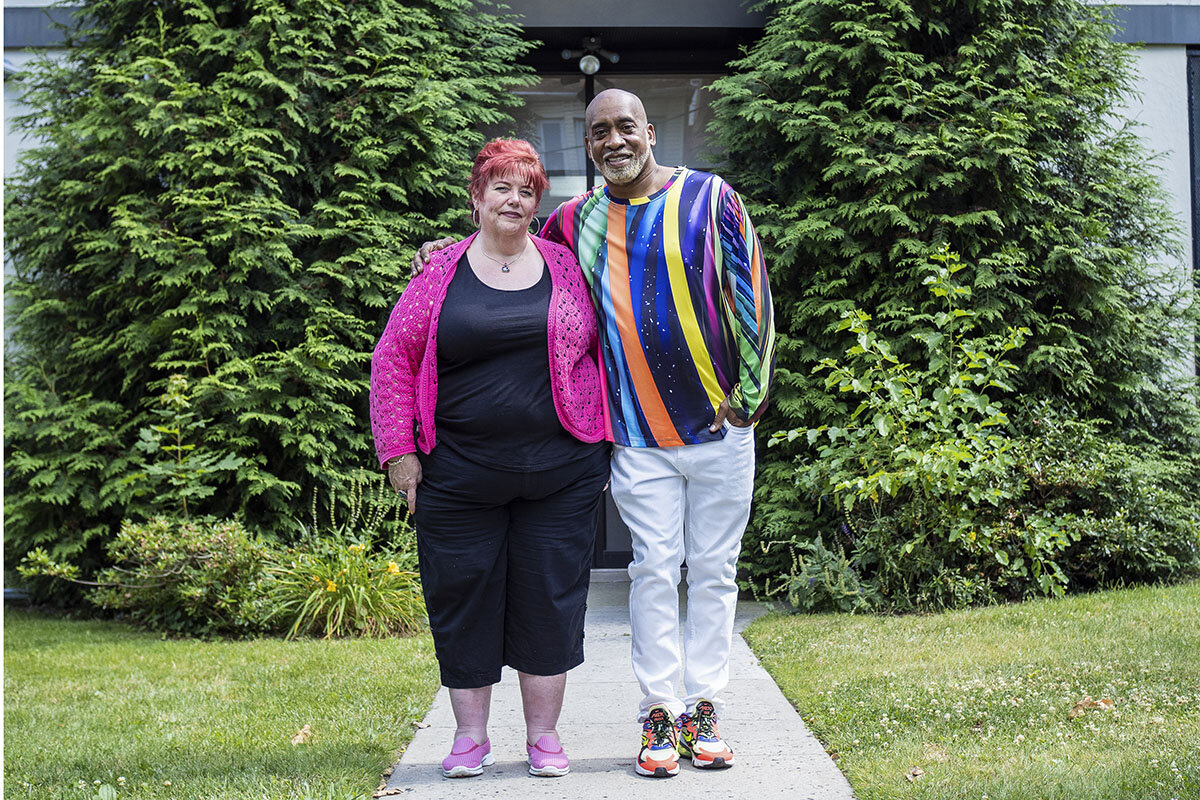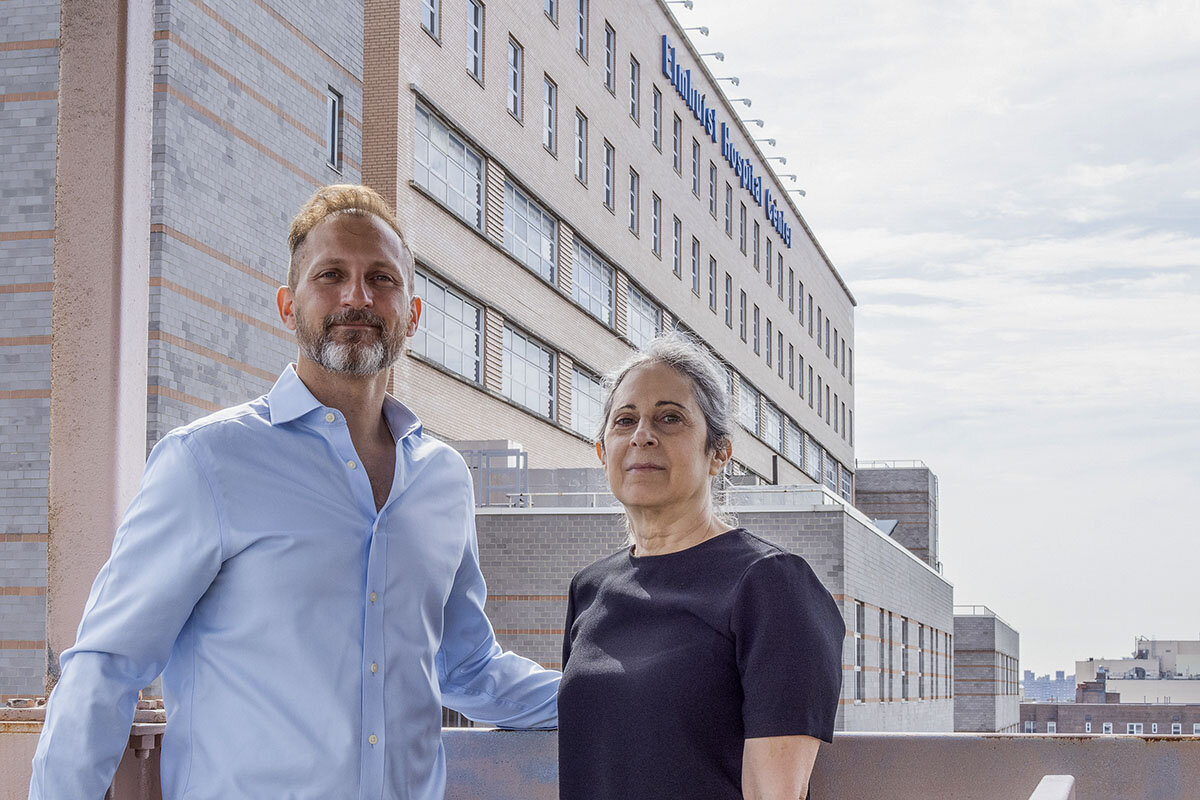New path for those recovering from addiction: Training to be peer advocates
Loading...
| New York
LaShondra Jones went through years of mental illness and alcohol addiction, and in her late 40s she was living in a women’s shelter in New York.
Finally stable and sober, she needed work – any type of work – for which her history wouldn’t count against her.
Ms. Jones Googled “free training in NYC” and learned that several area community colleges offered training for people to become certified recovery peer advocates for those coping with substance use disorder. Her experience, in this case, would be a big plus.
Why We Wrote This
A story focused onThose who have battled addiction now have another avenue for renewal: a chance to both go to school and have a meaningful career supporting others with sobriety.
There were obstacles. Ms. Jones needed special permission to stay out past the shelter bed check time because her classes at Bronx Community College ended at 9 p.m. and the subway trip back to Brooklyn could take hours. But she completed the training, passed the certification test, and now works as a certified recovery peer advocate with people in, or in danger of becoming caught up in, New York’s criminal justice system.
“I enjoy the fact I never know who I’m going to meet. I never know what their story is,” says the 50-something Ms. Jones, who now has her own apartment – and a job – in Manhattan. “I might be the only person who has ever listened to them.”
The success of Ms. Jones and others who have gone on to become recovery peer advocates shows that with the right financial and other kinds of support, and in fields where they can use their personal experiences, even some of the most vulnerable people can succeed at college-level training – and colleges can succeed at graduating them into good jobs.
This has become more important as the number of students over age 24 enrolled in higher education has continued to slide, down nearly 6%, and more than 16% at community colleges, since the start of the pandemic, according to the National Student Clearinghouse Research Center.
“Adults are disappearing from higher education. We have to build back their confidence,” says Van Ton-Quinlivan, chief executive officer of Futuro Health, a California nonprofit that helps train health care workers.
Futuro, in partnership with community colleges and employers, has provided training and education to more than 5,000 people for jobs such as patient care representatives, pharmacy technicians, and peer support specialists. It has found that even students who have been out of school for years will come back if they have flexibility in when and how they can learn and coursework that engages them. They also need ongoing support, but that support has to be subsidized by the government or employers to be affordable.
In addition, they need to know they’re training for jobs that are immediately available.
“Adults are skittish to commit to pursuing a degree,” Ms. Ton-Quinlivan says. “One way higher education can bring them back is through industry-valued certifications or credentials offered in a highly supportive environment.” Some of those students might continue on to a degree.
In a system that is often not very good at anticipating labor market demand, however, it can also take a confluence of events for such efforts to work.
While Ms. Jones got where she is through determination and hard work, national trends also helped drive her success. About 15% of Americans older than 12 have alcohol or drug use disorders, according to the federal Substance Abuse and Mental Health Services Administration, or SAMHSA; the numbers spiked during the pandemic due to opioid misuse, creating an urgent demand for more trained people to respond to the crisis.
More than a million peer support specialists are needed, SAMHSA estimates – more than 40 times the 23,507 now at work.
Meeting a need in New York
This gap between supply and demand – and the increasing number of training programs – means that some of the country’s most marginalized and ignored people now have a chance to acquire skills and find fulfilling employment.
The City University of New York’s College of Staten Island, or CSI, launched a certified recovery peer advocate training program in 2018 in response to the opioid epidemic. Until it was recently surpassed by the Bronx, Staten Island was the New York City borough with the highest rates of opiate overdoses and deaths.
“Every resident of Staten Island could say they were impacted in some way by substance use disorder,” says Lisa Spagnola, the college’s former director of workforce development, who helped establish its certified recovery peer advocate program. “Everybody can say they know someone who died of an overdose.”
Other types of training programs in New York State generally charge between $500 and $1,000, says Ruth Riddick, a spokesperson for Alcoholism and Substance Abuse Providers of New York State.
CSI sought out funding – primarily from the federal government – so students training to become peer advocates could attend for free. Another CUNY school, Queensborough Community College, already had its own recovery peer advocate program, so Ms. Spagnola used some of its curriculum in the CSI course design, along with input from prospective employers.
Raymond Jordan, who is in his late 50s, was part of the first group of graduates and since then has worked 25 hours per week at a local social service nonprofit called Project Hospitality.
Alienated as a young gay Black man whose mother died when he was 3 years old – and a drug user since he was 15 who was formerly incarcerated – Mr. Jordan had tried rehabilitation more times than he can count. He supported himself with prostitution and stealing and lived on the streets.
In 2017, he was sober and in outpatient treatment at Project Hospitality. Laura Novacek, the nonprofit’s associate area director, called him over.
“She asked me, ‘Raymond, would you be interested in becoming a peer?’ and told me about the program at CSI and said, ‘I think you’d be really good at it,’” Mr. Jordan says. His voice shaking, he adds, “That was the first time someone had believed in me.”
Mr. Jordan enrolled in the first recovery peer advocacy training class CSI offered in 2018. He loved the role-playing, which made him feel as if sharing his experience was helping someone.
“This is my first job,” Mr. Jordan says. “When Laura told me I was a valuable worker, I broke down. That’s why I’ve stayed clean, because I’m so happy to be alive, so happy to help others.”
Mr. Jordan’s remaining obstacle to becoming a certified peer advocate is the state’s certification test, which he has failed twice. He can take it as many times as needed, but has to wait 90 days and pay $80 each time; Project Hospitality picks up the licensing exam fees for its employees. In the meantime, Mr. Jordan works in the residential program, which, unlike outpatient care, doesn’t bill Medicaid for recovery peer advocacy reimbursement, so the peers don’t need to be certified.
Prospective students need a high school diploma or equivalent but often have limited work experience, so trainers have to judge the candidates primarily based on a sense of their potential.
“That means someone great at listening, able to share their recovery story in order to inspire others, and able to work on a team,” says Curtis Dann-Messier, founding director of the NYC Health + Hospitals Peer Academy, which was established last year to train peers to work in the city’s public health system.
At CSI’s information sessions, prospective students are told about the requirements for the program, the jobs available, including how much money they could make (barely above minimum wage, without much room for promotion, though national groups are trying hard to change this), and the demand for graduates. If they’re still interested, they sign up for a 30-minute interview.
Many of those who apply to the peer programs never enroll once they realize the time and effort required. But, according to administrators, 70% to 90% of students who start the courses at the Peer Academy and at New York City’s three community colleges where they’re offered finish them.
Those who join the programs say the combination of support from teachers and classmates, engaging coursework that emphasizes role-playing and the sharing of personal experiences, and the realization that they can go on to meaningful careers keeps them coming back to class even when life feels overwhelming.
Kevser Ermendi says she has a long history of starting courses and not finishing them, then falling back into drugs. The CSI recovery peer advocate program was the first classwork she’s completed since high school. She passed the certification test and now works at a community organization on Staten Island.
“It was fun to go to class. It wasn’t something I dreaded,” says Ms. Ermendi, who is in her 60s. “It was the first time in my life that my substance use history became an asset instead of a liability. It was definitely a topic I knew back and forwards.”
Often trainers themselves are also recovering from addiction, and many of the students in recovery said they are the best equipped to do the job.
Ms. Ermendi notes the difficulty of working with counselors who have not misused drugs: “If I’m in a treatment facility and I’m a patient, you’re not really my peer,” she says. ”You don’t know what it’s like to have this voice in your head that’s telling you you have to use.”
“It chose me”
While struggling with alcohol addiction, Jack Chudasama was at one point drinking a gallon of vodka a day. Five years ago, when his wife threatened him with divorce and his children told him they wished he were dead, he stopped drinking and has been in recovery for five years.
He is one of 18 students in the first class of the Peer Academy who graduated in June, Mr. Dann-Messier says, and was recently hired by a Queens hospital as a peer.
The Peer Academy, housed in the downtown Manhattan office of NYC Health + Hospitals, is free – and intense: Students have to commit to about three months of full-time attendance, with 177 hours of classroom training, 126 hours of a hospital-based internship, and at least 20 hours of online workshops.
For the 50-something Mr. Chudasama, the most surreal aspect was “transitioning from being in the bed to being on the other side with the treatment team. I was always used to being a patient.”
Mr. Chudasama, who was born in India but moved to the U.S. with his family as a child, appreciates that some Indian patients who won’t communicate with the medical team have opened up to him.
“I see this as a career opportunity and not just a job,” he says. “I saw this as an opportunity to do what I want to do and love.”
Ms. Jones was working two peer advocate jobs for a while. But then she was offered a full-time position with the Center for Alternative Sentencing and Employment Services, a nonprofit that focuses on providing services for people in or potentially involved with the criminal justice system. She makes a decent salary and gets benefits. And her bosses understand if she’s having a bad day and needs to take off or work with clients by phone.
The other peer advocates at her organization, which has branches around the city, just started their own support group. And now she has a formerly incarcerated client who wants to be a peer, whom she hopes to guide down the same path she took.
She has now signed up for an online bachelor’s program in wellness and nutrition; she’s still sometimes amazed at where she has landed.
“I feel like I didn’t choose this profession,” she says. “It chose me.”
This story about higher education for adults over age 24 was produced by The Hechinger Report, a nonprofit, independent news organization focused on inequality and innovation in education, and supported by the Institute for Citizens & Scholars Higher Education Media Fellowship.







